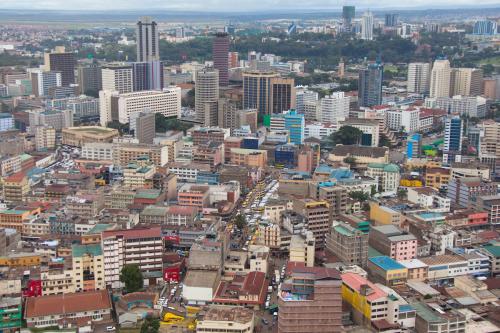Habitat III begins next week, from October 17-20, during which time policymakers and urban leaders will descend on Quito, Ecuador, to adopt the New Urban Agenda. While sub-Saharan Africa and its cities share much in common with the rest of the world, the region is rapidly becoming the fastest-urbanizing one on the planet and faces unique obstacles of its own. As Africa-tied urban actors gather in Quito, they should keep the below recommendations in mind.
The context
Recent discussions of global economic growth have agreed on a single fact: It’s slowing down. The global economy is expected to grow by just 3.2 percent in 2016, and even developing Africa is expected to grow by only 3 percent, compared to an average of 5.5 percent over the period 2000-2015.
Indeed, despite this downturn, a recent World Bank report highlights a relative bright spot: cities. According to this report, 72 percent of the world’s 750 largest cities have outpaced the growth of their national economies since the early 2000s. And among these cities, a few outpaced their national economies on rates of private sector job creation, productivity, and income per capita growth. The top 10 percent of these cities-that outperformed their countries on: private sector job growth, productivity growth, and disposable income per capita growth- saw an average annual growth rate of 13.5 percent in GDP per capita (compared to 4.7 percent growth in GDP per capita in the average city). Since the proportion of urban dwellers in Africa is expected to grow from 36 percent in 2010 to 50 percent in 2030, harnessing Africa’s urban potential could present the continent with a vast opportunity for growth. Job creation—along with improved infrastructure, increased food security, and a reduction in slum-dwelling—are just some of the potential benefits of successfully managing African urbanization.
However, certain challenges specific to the African context must be addressed in order to fully benefit from the opportunities presented by urbanization.
However, certain challenges specific to the African context must be addressed in order to fully benefit from the opportunities presented by urbanization. Unclear land rights, inadequate infrastructure, weak local governments, and financing constraints constitute some of the most serious obstacles to successful urbanization.
Managing urban potential
Below we present a few key policy recommendations for managing Africa’s urban potential:
- Clarify land rights. Urban land rights and land tenure policies are often unclear in Africa. In fact, seven of the 10 countries with the weakest policies on secure access to land in the world are found in sub-Saharan Africa. The lack of clarity inhibits land from functioning as collateral for mortgage purposes and encourages horizontal city expansion via the growth of informal settlements.
- Target intermediary cities. As two-thirds of urban growth between 2010 and 2030 is predicted to take place in cities under 500,000, particular attention should be paid to intermediary cities which can relieve some of the demographic stress on megacities, offer prime locations for labor-intensive industries like food processing and textiles, which then increase market access to, and rural nonfarm employment opportunities for smallholder farmers. Analysis of poverty reduction patterns in 51 developing countries shows that rural diversification and secondary town development lead to more inclusive growth patterns than metropolitization.
- Empower local governments. Local governments are often best equipped to deal with city-specific issues like infrastructure, housing, public transportation, and land allocation—though they typically wield little power to do so. Empowering local governments includes not only reallocating more resources to them, but allowing them to plan, budget, execute programs efficiently, and making them accountable for their program’s outcomes, and letting them create favorable policies to recruit businesses, incentivize investment, and foster the realization of agglomeration economies in these sectors
- Support public-private partnerships. Since private sector growth accounts for 75 percent of global job creation, public-private dialogue is essential to city growth in order to cater to the needs of and address the challenges faced by business leaders. For example, in Kigali, Rwanda, the municipal government established the Kigali Investors Forum, which brought together private sector leaders in order to identify and address business climate-related concerns. Public-private partnerships can also enable the establishment of vocational schools that specialize in the expressed needs of private firms, creating new employment opportunities for their students.
Domestic resource mobilization for financing urban potential
Financial constraints have been a sizable obstacle to successfully managing urbanization. National governments control the majority of public revenue and tend to under-allocate resources to municipalities—in 2010, African local governments received an average of 11.7 percent of the national government’s budget, compared to the near 25 percent average allocation rate in OECD countries. Given the difficult political economy of resource allocation to local administrations, it is thus necessary for local governments to consider alternative sources of funding.
- Local taxes. Due to local governments’ lack of authority, their ability to generate and collect local taxes has been largely insufficient. Even compared to other developing nations, such as Colombia and the Philippines, the level of local taxation in Africa is low. State and local governments both stand to benefit from transferring control of local tax collection to local authorities, as the increased revenue could be shared between the two bodies.

- Borrowing. Commercial loans and municipal bonds, when wielded responsibly, could significantly increase the autonomy of local governments and provide a budget with which these governments could realize well-planned urban development programs. Johannesburg and Lagos have both increased their financial autonomy by issuing municipal bonds, with which Lagos State is now able to generate 60 percent of its own budget.
- Capturing land value. Property taxes, coupled with clear land rights, can help capture and equitably allocate increases in urban land value. New technology is transforming the way African governments can monitor economic activity in urban regions, determine efficient zoning and accurately tax landowners. In settings where private ownership of land is uncommon, local governments could oversee the development of state-owned land, which could then be sold for profit and reinvested into urban development projects, as has been done in China. In Morocco, as part of a slum removal strategy, households in an informal settlement were granted a plot of land and the rights to build up to three or four stories. These households had the option of partnering with another household with housing needs and a third party with a commercial interest, who would finance the construction of a multi-story building in exchange for rights to part of it, while the two families would receive apartments. These agreements efficiently allocated space for both private and commercial purposes, and created job opportunities in the neighborhood when businesses moved into the new buildings.
- Public-private partnerships. Public-private partnerships can take many forms, but all require cooperation between the public and private sector to design, build, manage, and finance projects that could not be undertaken by the public sector alone.
Sarah Baker contributed to this post.



Commentary
Unlocking urban potential in Africa
October 14, 2016